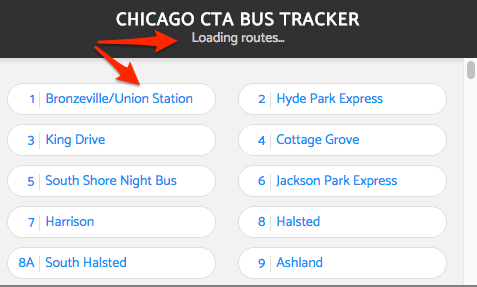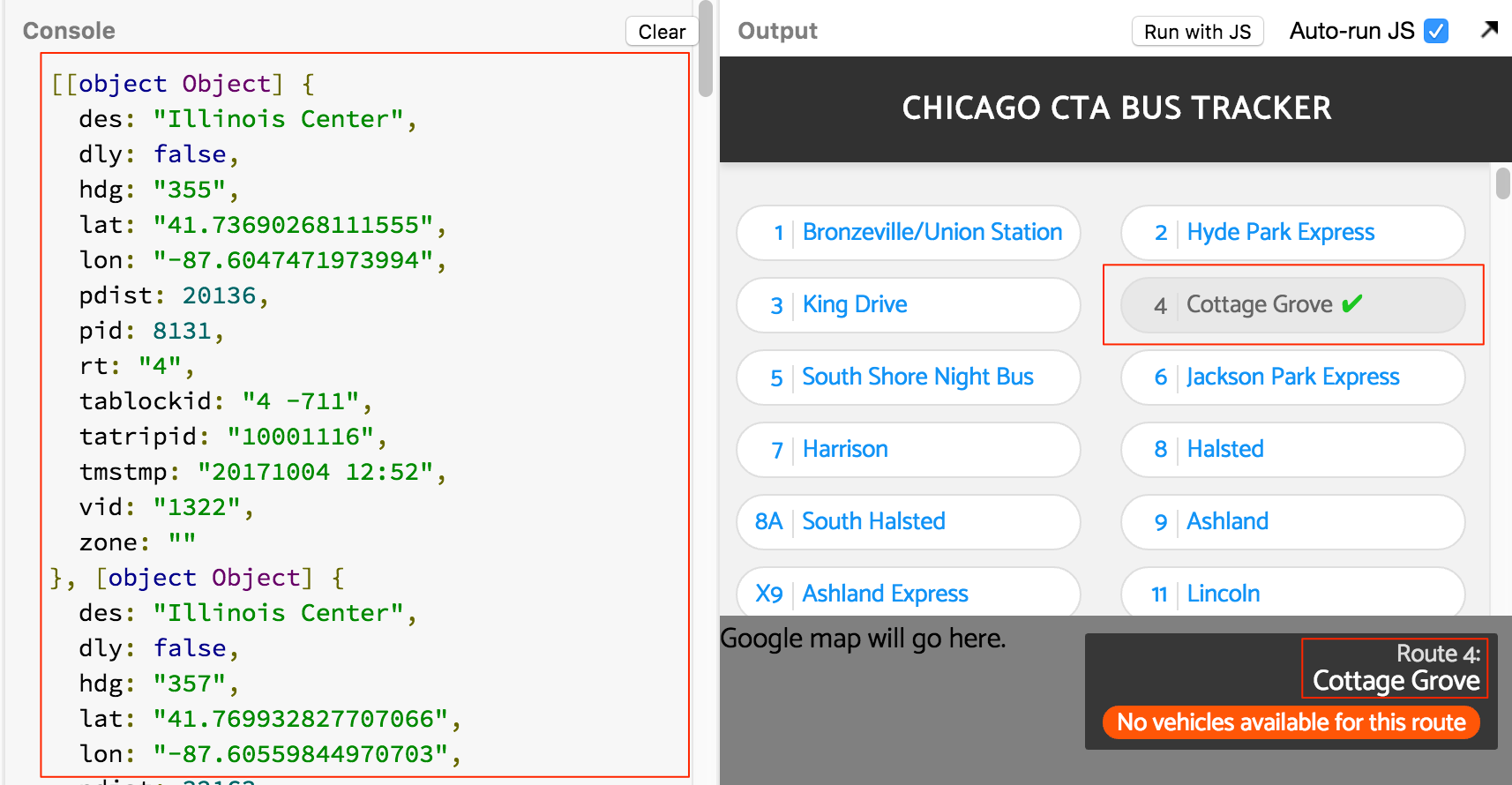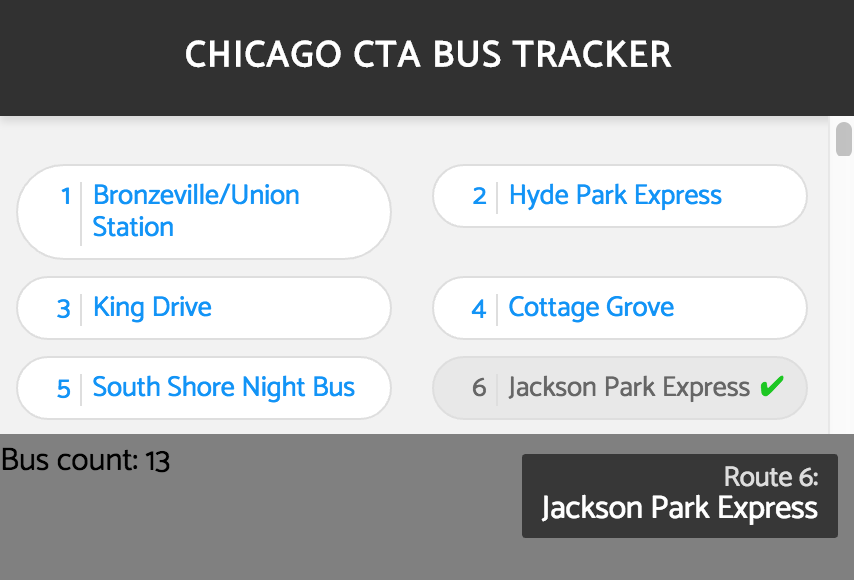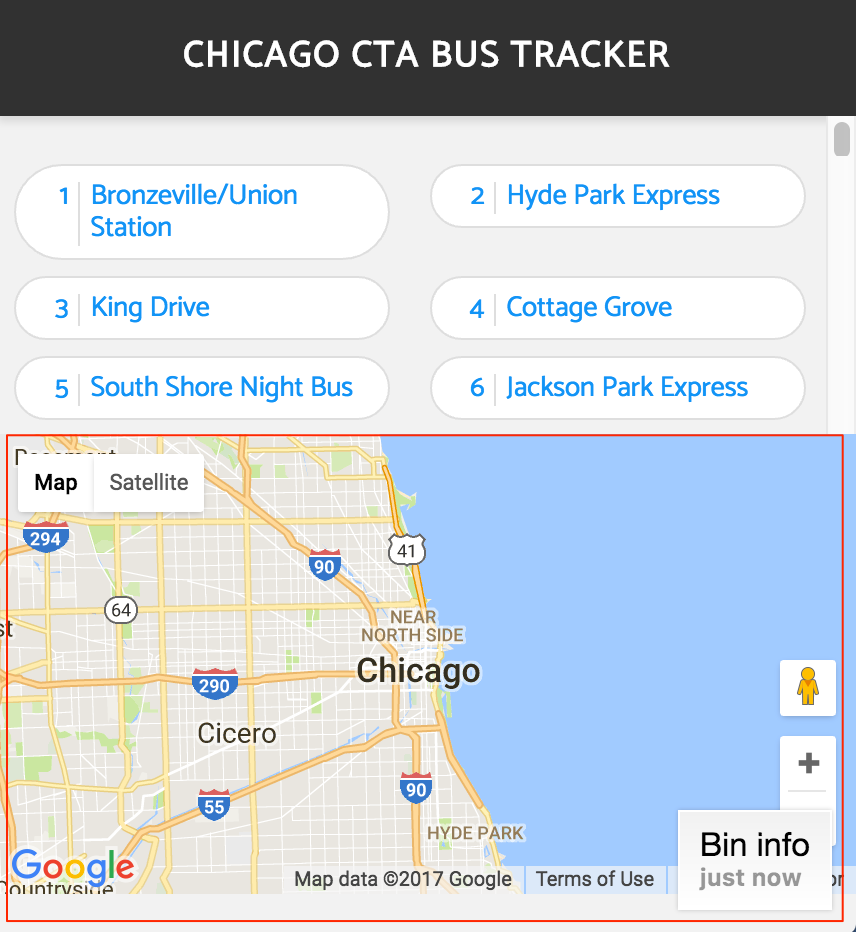CTA Bus Map (Medium)
This guide walks you through showing Chicago Transit Authority (CTA) bus locations on a Google Map.
In this guide, you will learn how to:
- Use
fetchto request data. - Create a custom element that wraps a google map.
- Add markers to the google map.
The final widget looks like:
To use the widget:
- Click a Bus Route.
- Explore the markers added to the Google Map showing the bus locations for that route.
- Click the route name overlay to refresh the bus locations.
The following sections are broken down the following parts:
- The problem — A description of what the section is trying to accomplish.
- What you need to know — Information about CanJS that is useful for solving the problem.
- How to verify it works - How to make sure the solution works if it's not obvious.
- The solution — The solution to the problem.
Setup
START THIS TUTORIAL BY CLONING THE FOLLOWING JS BIN:
Click the
JS Binbutton. The JSBin will open in a new window. In that new window, underFile, clickClone.
This JS Bin has initial prototype HTML and CSS which is useful for getting the application to look right.
What you need to know
There's nothing to do in this step. The JSBin is already setup with:
- A basic CanJS setup.
- A promise that resolves when the Google Maps has loaded.
- Some variables useful to make requests to get bus routes and locations.
Please read on to understand the setup.
A Basic CanJS Setup
A basic CanJS setup uses instances of a ViewModel to manage the behavior of a View. A ViewModel type is defined, an instance of it is created and passed to a View as follows:
// Define the ViewModel type const MyViewModel = can.DefineMap.extend("MyViewModel",{ ... }) // Create an instance of the ViewModel const viewModel = new MyViewModel(); // Get a View const view = can.stache.from("my-view"); // Render the View with the ViewModel instance const fragment = view(viewModel); document.body.appendChild(fragment);CanJS uses can-stache to render data in a template and keep it live. Templates can be authored in
<script>tags like:<script type="text/stache" id="app-view"> TEMPLATE CONTENT </script>A can-stache template uses {{key}} "magic tags" to insert data into the HTML output like:
<script type="text/stache" id="app-view"> {{something.name}} </script>Load a template from a
<script>tag with can.stache.from like:const template = can.stache.from(SCRIPT_ID);Render the template with data into a documentFragment like:
const fragment = template({ something: {name: "Derek Brunson"} });Insert a fragment into the page with:
document.body.appendChild(fragment);
Loading Google Maps API
The following loads Google Maps API:
<script>
window.googleAPI = new Promise(function(resolve){
const script = document.createElement("script");
script.src = "https://maps.googleapis.com/maps/api/js?key=AIzaSyD7POAQA-i16Vws48h4yRFVGBZzIExOAJI";
document.body.appendChild( script );
script.onload = resolve;
});
</script>
It creates a global googleAPI promise that resolves when Google Maps is ready. You can use it like:
googleAPI.then(function(){
new google.maps.Map( ... );
})
Loading CTA Bus Data
This app needs to make requests to the http://www.ctabustracker.com/ API. The
ctabustracker API is hosted at:
const apiRoot = "http://www.ctabustracker.com/bustime/api/v2/"
The API needs a token as part of the request:
const token = "?key=piRYHjJ5D2Am39C9MxduHgRZc&format=json";
However, the API does not support cross origin requests. Therefore, we will request data using a proxy hosted at:
const proxyUrl = "https://can-cors.herokuapp.com/"
With that proxy, the requests for this app will look like:
fetch("https://can-cors.herokuapp.com/"+
"http://www.ctabustracker.com/bustime/api/v2/"+
"getroutes"+
"?key=piRYHjJ5D2Am39C9MxduHgRZc&format=json")
Change the app title
The problem
In this section, we will:
- Explore the relationship between ViewModel and View.
- Make it so the title of the page changes from
<h1>YOUR TITLE HERE</h1>to<h1>CHICAGO CTA BUS TRACKER</h1>. - Let us adjust the title simply by changing the viewModel like:
viewModel.title = "TITLE UPDATED"

What you need to know
A can-stache template uses {{key}} magic tags to insert data into the HTML output like:
{{someValue}}These values come from a ViewModel or Model.
The default property definition can return the initial value of a property like:
const AppViewModel = can.DefineMap.extend({ someValue: { default: "This string" } }); new AppViewModel().someValue //-> "This string"
How to verify it works
Run the following in the Console tab:
viewModel.title = "TITLE UPDATED"
You should see the title update.
The solution
Update the view in the HTML tab to:
<div class="top">
<div class="header">
<h1>{{title}}</h1>
<p>Loading routes…</p>
</div>
<ul class="routes-list">
<li>
<span class="route-number">1</span>
<span class="route-name">Bronzeville/Union Station</span>
<span class="check">✔</span>
</li>
<li class="active">
<span class="route-number">2</span>
<span class="route-name">Hyde Park Express</span>
<span class="check">✔</span>
</li>
</ul>
</div>
<div class="bottom">
<div class="route-selected">
<small>Route 2:</small> Hyde Park Express
<div class="error-message">No vehicles available for this route</div>
</div>
<div class='gmap'>Google map will go here.</div>
</div>
Update the JavaScript tab to:
const proxyUrl = "https://can-cors.herokuapp.com/";
const token = "?key=piRYHjJ5D2Am39C9MxduHgRZc&format=json";
const apiRoot = "http://www.ctabustracker.com/bustime/api/v2/"
const getRoutesEnpoint = apiRoot + "getroutes" + token;
const getVehiclesEndpoint = apiRoot + "getvehicles" + token;
const BusTrackerVM = can.DefineMap.extend({
title: {
default: "Chicago CTA Bus Tracker"
}
});
const viewModel = new BusTrackerVM();
const view = can.stache.from("app-view");
const fragment = view(viewModel);
document.body.appendChild(fragment);
List bus routes
The problem
In this section, we will:
- Load and list bus routes.
- Show
<p>Loading routes…</p>while loading routes.

We will do this by:
- Store the promise of bus routes in a
routesPromiseproperty. routesPromisewill resolve to anArrayof the routes.- Loop through each route and add an
<li>to the page. - Show the loading message while
routesPromiseis pending.
What you need to know
The default property definition can return the initial value of a property like:
const AppViewModel = can.DefineMap.extend({ myProperty: { default: function(){ return new Promise( .... ); } } }); new AppViewModel().myProperty //-> PromiseThe fetch API is an easy way to make requests to a URL and get back JSON. Use it like:
fetch(url).then(function(response){ return response.json(); }).then(function(data){ });You'll want to use the
proxyUrlandgetRoutesEnpointvariables to make a request for CTA bus routes. The routes service returns data like:{ "bustime-response": { "routes": [ { "rt": "1", "rtnm": "Bronzeville/Union Station", "rtclr": "#336633", "rtdd": "1" }, ... ] } }Make sure that
routesPromisewill be a Promise that resolves to an array of routes.Promises can transform data by returning new values. For example if
outerPromiseresolves to{innerData: {name: "inner"}},resultPromisewill resolve to{name: "inner"}:const resultPromise = outerPromise.then(function(data){ return data.innerData; });Use {{#if(value)}} to do
if/elsebranching incan-stache.Use {{#each(value)}} to do looping in
can-stache.Promises are observable in can-stache. Given a promisesomePromise, you can:- Check if the promise is loading like:
{{#if(somePromise.isPending)}}. - Loop through the resolved value of the promise like:
{{#each(somePromise.value)}}.
- Check if the promise is loading like:
The solution
Update the view in the HTML tab to:
<div class="top">
<div class="header">
<h1>{{title}}</h1>
{{#if(routesPromise.isPending)}}<p>Loading routes…</p>{{/if}}
</div>
<ul class="routes-list">
{{#each(routesPromise.value)}}
<li>
<span class="route-number">{{rt}}</span>
<span class="route-name">{{rtnm}}</span>
<span class="check">✔</span>
</li>
{{/each}}
</ul>
</div>
<div class="bottom">
<div class="route-selected">
<small>Route 2:</small> Hyde Park Express
<div class="error-message">No vehicles available for this route</div>
</div>
<div class='gmap'>Google map will go here.</div>
</div>
Update the JavaScript tab to:
const proxyUrl = "https://can-cors.herokuapp.com/";
const token = "?key=piRYHjJ5D2Am39C9MxduHgRZc&format=json";
const apiRoot = "http://www.ctabustracker.com/bustime/api/v2/"
const getRoutesEnpoint = apiRoot + "getroutes" + token;
const getVehiclesEndpoint = apiRoot + "getvehicles" + token;
const BusTrackerVM = can.DefineMap.extend({
title: {
default: "Chicago CTA Bus Tracker"
},
routesPromise: {
default() {
return fetch(proxyUrl + getRoutesEnpoint)
.then(response => response.json())
.then(data => data["bustime-response"].routes);
}
}
});
const viewModel = new BusTrackerVM();
const view = can.stache.from("app-view");
const fragment = view(viewModel);
document.body.appendChild(fragment);
Pick a route and log bus locations
The problem
In this section, we will:
- Highlight the selected bus route after a user clicks it.
- Log the bus (vehicle) locations for the selected route.

We will do this by:
- Listening to when a user clicks one of the bus routes.
- Adding
activeto the class name of that route's<li>like:<li class="active">. - Making the request for the vehicle locations of the selected route.
What you need to know
Use on:event to listen to an event on an element and call a method in
can-stache. For example, the following callsdoSomething()when the<div>is clicked:<div on:click="doSomething()"> ... </div>Use the
"any"type to define a property of indeterminate type:const AppViewModel = can.DefineMap.extend({ myProperty: "any" }); const viewModel = new AppViewModel({}); viewModel.myProperty = ANYTHING;You'll want to store the selected bus route as
route.Use
fetch(proxyUrl + getVehiclesEndpoint + "&rt=" + route.rt)to get the vehicles for a particular route. If there is route data, it comes back like:{ "bustime-response": { "vehicle": [ { "vid": "8026", "tmstmp": "20171004 09:18", "lat": "41.73921241760254", "lon": "-87.66306991577149", "hdg": "359", "pid": 3637, "rt": "9", "des": "74th", "pdist": 6997, "dly": false, "tatripid": "10002232", "tablockid": "X9 -607", "zone": "" }, ... ] } }If there is an error or no buses, the response looks like:
{ "bustime-response": { "error": [ { "rt": "5", "msg": "No data found for parameter" } ] } }
How to verify it works
In the Console tab, when you click a bus route (like Cottage Grove), you should see
an array of bus routes.
The solution
Update the view in the HTML tab to:
<div class="top">
<div class="header">
<h1>{{title}}</h1>
{{#if(routesPromise.isPending)}}<p>Loading routes…</p>{{/if}}
</div>
<ul class="routes-list">
{{#each(routesPromise.value)}}
<li on:click="../pickRoute(this)" {{#eq(this, ../route)}}class="active"{{/eq}}>
<span class="route-number">{{this.rt}}</span>
<span class="route-name">{{this.rtnm}}</span>
<span class="check">✔</span>
</li>
{{/each}}
</ul>
</div>
<div class="bottom">
{{#if(route)}}
<div class="route-selected">
<small>Route {{route.rt}}:</small> {{route.rtnm}}
<div class="error-message">No vehicles available for this route</div>
</div>
{{/if}}
<div class="gmap">Google map will go here.</div>
</div>
Update the JavaScript tab to:
const proxyUrl = "https://can-cors.herokuapp.com/";
const token = "?key=piRYHjJ5D2Am39C9MxduHgRZc&format=json";
const apiRoot = "http://www.ctabustracker.com/bustime/api/v2/"
const getRoutesEnpoint = apiRoot + "getroutes" + token;
const getVehiclesEndpoint = apiRoot + "getvehicles" + token;
const BusTrackerVM = can.DefineMap.extend({
title: {
default: "Chicago CTA Bus Tracker"
},
routesPromise: {
default() {
return fetch(proxyUrl + getRoutesEnpoint)
.then(response => response.json())
.then(data => data["bustime-response"].routes);
}
},
route: "any",
pickRoute(route) {
this.route = route;
fetch(proxyUrl + getVehiclesEndpoint + "&rt=" + route.rt)
.then(response => response.json())
.then(data => {
if (data["bustime-response"].error) {
console.log(data["bustime-response"].error);
} else {
console.log( data["bustime-response"].vehicle );
}
});
}
});
const viewModel = new BusTrackerVM();
const view = can.stache.from("app-view");
const fragment = view(viewModel);
document.body.appendChild(fragment);
Show when buses are loading and the number of buses
The problem
In this section, we will:
- Show
<p>Loading vehicles…</p>while bus data is being loaded. - Show
<div class="error-message">No vehicles available for this route</div>in the overlay if the request for bus data failed. - Show the number of buses inside the
<div class="gmap">like:Bus count: 20.

We will do this by:
- Defining and setting a
vehiclesPromiseproperty.
What you need to know
- In stache, you can check if a promise was rejected like:
{{#if(somePromise.isRejected)}}<p>...</p>{{/if}} - The Promise.reject method returns a rejected promise with the provided
reason:const rejectedPromise = Promise.reject({message: "something went wrong"}); - Promises can transform data by returning new promises. For example if
outerPromiseresolves to{innerData: {name: "inner"}},resultPromisewill be a rejected promise with thereasonas{name: "inner"}:const resultPromise = outerPromise.then(function(data){ return Promise.reject(data.innerData); }); resultPromise.catch(function(reason){ reason.name //-> "inner" });
The solution
Update the view in the HTML tab to:
<div class="top">
<div class="header">
<h1>{{title}}</h1>
{{#if(routesPromise.isPending)}}<p>Loading routes…</p>{{/if}}
{{#if(vehiclesPromise.isPending)}}<p>Loading vehicles…</p>{{/if}}
</div>
<ul class="routes-list">
{{#each(routesPromise.value)}}
<li on:click="../pickRoute(this)" {{#eq(this, ../route)}}class="active"{{/eq}}>
<span class="route-number">{{this.rt}}</span>
<span class="route-name">{{this.rtnm}}</span>
<span class="check">✔</span>
</li>
{{/each}}
</ul>
</div>
<div class="bottom">
{{#if(route)}}
<div class="route-selected">
<small>Route {{route.rt}}:</small> {{route.rtnm}}
{{#if(vehiclesPromise.isRejected)}}
<div class="error-message">No vehicles available for this route</div>
{{/if}}
</div>
{{/if}}
<div class="gmap">Bus count: {{vehiclesPromise.value.length}}</div>
</div>
Update the JavaScript tab to:
const proxyUrl = "https://can-cors.herokuapp.com/";
const token = "?key=piRYHjJ5D2Am39C9MxduHgRZc&format=json";
const apiRoot = "http://www.ctabustracker.com/bustime/api/v2/"
const getRoutesEnpoint = apiRoot + "getroutes" + token;
const getVehiclesEndpoint = apiRoot + "getvehicles" + token;
const BusTrackerVM = can.DefineMap.extend({
title: {
default: "Chicago CTA Bus Tracker"
},
routesPromise: {
default() {
return fetch(proxyUrl + getRoutesEnpoint)
.then(response => response.json())
.then(data => data["bustime-response"].routes);
}
},
route: "any",
vehiclesPromise: "any",
pickRoute(route) {
this.route = route;
this.vehiclesPromise = fetch(proxyUrl + getVehiclesEndpoint + "&rt=" + route.rt)
.then(response => response.json())
.then(data => {
if (data["bustime-response"].error) {
return Promise.reject(data["bustime-response"].error[0]);
} else {
return data["bustime-response"].vehicle;
}
});
}
});
const viewModel = new BusTrackerVM();
const view = can.stache.from("app-view");
const fragment = view(viewModel);
document.body.appendChild(fragment);
Initialize Google Maps to show Chicago
The problem
In this section, we will:
- Create a custom
<google-map-view/>element that adds a google map. - The google map should be added to a
<div class="gmap"/>element. - The google map should be centered on Chicago (latitude:
41.881, longitude-87.623).

We will do this by:
- Creating a custom can-component element that adds the
<div class="gmap"/>to its HTML. - Listens to when the element is in the page and creates a new google map.
What you need to know
Use can-component to create custom elements. Start by extending
Componentwith thetagof the element:can.Component.extend({ tag: "google-map-view" });Next, provide the HTML can-stache template with the content you want to insert within the element.
can.Component.extend({ tag: "google-map-view", view: can.stache(`<div class="gmap"/>`) });Any values you want the custom element to hold must be defined on the
ViewModel. If theViewModelis a plainObject, that object will be used to extend DefineMap and create a new type. The following specifies amapproperty that can be any value:can.Component.extend({ tag: "google-map-view", view: can.stache(`<div class="gmap"/>`), ViewModel: { map: "any" } });A ViewModel's connectedCallback can be used to know when the component's element is inserted into the document as follows:
can.Component.extend({ tag: "google-map-view", view: can.stache(`<div class="gmap"/>`), ViewModel: { map: "any" connectedCallback(element) { this // -> the ViewModel instance element // -> the <google-map-view> element } } });To create a google map, use new google.map.Map(...) once the
googleAPIhas completed loading:new google.maps.Map(gmapDiv, { zoom: 10, center: { lat: 41.881, lng: -87.623 } })
The solution
Update the view in the HTML tab to:
<div class="top">
<div class="header">
<h1>{{title}}</h1>
{{#if(routesPromise.isPending)}}<p>Loading routes…</p>{{/if}}
{{#if(vehiclesPromise.isPending)}}<p>Loading vehicles…</p>{{/if}}
</div>
<ul class="routes-list">
{{#each(routesPromise.value)}}
<li on:click="../pickRoute(this)" {{#eq(this, ../route)}}class="active"{{/eq}}>
<span class="route-number">{{this.rt}}</span>
<span class="route-name">{{this.rtnm}}</span>
<span class="check">✔</span>
</li>
{{/each}}
</ul>
</div>
<div class="bottom">
{{#if(route)}}
<div class="route-selected">
<small>Route {{route.rt}}:</small> {{route.rtnm}}
{{#if(vehiclesPromise.isRejected)}}
<div class="error-message">No vehicles available for this route</div>
{{/if}}
</div>
{{/if}}
<google-map-view/>
</div>
Update the JavaScript tab to:
const proxyUrl = "https://can-cors.herokuapp.com/";
const token = "?key=piRYHjJ5D2Am39C9MxduHgRZc&format=json";
const apiRoot = "http://www.ctabustracker.com/bustime/api/v2/"
const getRoutesEnpoint = apiRoot + "getroutes" + token;
const getVehiclesEndpoint = apiRoot + "getvehicles" + token;
const BusTrackerVM = can.DefineMap.extend({
title: {
default: "Chicago CTA Bus Tracker"
},
routesPromise: {
default() {
return fetch(proxyUrl + getRoutesEnpoint)
.then(response => response.json())
.then(data => data["bustime-response"].routes);
}
},
route: "any",
vehiclesPromise: "any",
pickRoute(route) {
this.route = route;
this.vehiclesPromise = fetch(proxyUrl + getVehiclesEndpoint + "&rt=" + route.rt)
.then(response => response.json())
.then(data => {
if (data["bustime-response"].error) {
return Promise.reject(data["bustime-response"].error[0]);
} else {
return data["bustime-response"].vehicle;
}
});
}
});
can.Component.extend({
tag: "google-map-view",
view: can.stache(`<div class="gmap"></div>`),
ViewModel: {
map: "any",
connectedCallback(element) {
googleAPI.then(() => {
this.map = new google.maps.Map(element.firstChild, {
zoom: 10,
center: {
lat: 41.881,
lng: -87.623
}
});
});
}
}
});
const viewModel = new BusTrackerVM();
const view = can.stache.from("app-view");
const fragment = view(viewModel);
document.body.appendChild(fragment);
Set markers for vehicle locations
The problem
In this section, we will:
- Show markers at bus locations when the user clicks a route.
We will do this by:
- Passing the
vehiclesfromvehiclePromiseto<google-map-view>. - Listening when
vehicleschanges and creating google mapMarkers.
What you need to know
childProp:from can set a component's ViewModel from another value:
<google-map-view viewModelProp:from="scopeValue"/>A component's events object can be used to listen to events on the
ViewModelinstance with:"{viewModel} propertyName"like:can.Component.extend({ ... events: { "{viewModel} vehicles": function(viewModel, event, newVehicles) { // do stuff with the newVehicles } } })Use new google.maps.Marker to add a marker to a map like:
new google.maps.Marker({ position: { lat: parseFloat(vehicle.lat), lng: parseFloat(vehicle.lon) }, map: this.viewModel.map });
The solution
Update the view in the HTML tab to:
<div class="top">
<div class="header">
<h1>{{title}}</h1>
{{#if(routesPromise.isPending)}}<p>Loading routes…</p>{{/if}}
{{#if(vehiclesPromise.isPending)}}<p>Loading vehicles…</p>{{/if}}
</div>
<ul class="routes-list">
{{#each(routesPromise.value)}}
<li on:click="../pickRoute(this)" {{#eq(this, ../route)}}class="active"{{/eq}}>
<span class="route-number">{{this.rt}}</span>
<span class="route-name">{{this.rtnm}}</span>
<span class="check">✔</span>
</li>
{{/each}}
</ul>
</div>
<div class="bottom">
{{#if(route)}}
<div class="route-selected">
<small>Route {{route.rt}}:</small> {{route.rtnm}}
{{#if(vehiclesPromise.isRejected)}}
<div class="error-message">No vehicles available for this route</div>
{{/if}}
</div>
{{/if}}
<google-map-view vehicles:from="vehiclesPromise.value"/>
</div>
Update the JavaScript tab to:
const proxyUrl = "https://can-cors.herokuapp.com/";
const token = "?key=piRYHjJ5D2Am39C9MxduHgRZc&format=json";
const apiRoot = "http://www.ctabustracker.com/bustime/api/v2/"
const getRoutesEnpoint = apiRoot + "getroutes" + token;
const getVehiclesEndpoint = apiRoot + "getvehicles" + token;
const BusTrackerVM = can.DefineMap.extend({
title: {
default: "Chicago CTA Bus Tracker"
},
routesPromise: {
default() {
return fetch(proxyUrl + getRoutesEnpoint)
.then(response => response.json())
.then(data => data["bustime-response"].routes);
}
},
route: "any",
vehiclesPromise: "any",
pickRoute(route) {
this.route = route;
this.vehiclesPromise = fetch(proxyUrl + getVehiclesEndpoint + "&rt=" + route.rt)
.then(response => response.json())
.then(data => {
if (data["bustime-response"].error) {
return Promise.reject(data["bustime-response"].error[0]);
} else {
return data["bustime-response"].vehicle;
}
});
}
});
can.Component.extend({
tag: "google-map-view",
view: can.stache(`<div class="gmap"></div>`),
ViewModel: {
map: "any",
connectedCallback(element) {
googleAPI.then(() => {
this.map = new google.maps.Map(element.firstChild, {
zoom: 10,
center: {
lat: 41.881,
lng: -87.623
}
});
});
},
vehicles: "any"
},
events: {
"{viewModel} vehicles": function(vm, ev, newVehicles) {
if ( newVehicles ) {
newVehicles.map(vehicle => {
return new google.maps.Marker({
position: {
lat: parseFloat(vehicle.lat),
lng: parseFloat(vehicle.lon)
},
map: this.viewModel.map
});
});
}
}
}
});
const viewModel = new BusTrackerVM();
const view = can.stache.from("app-view");
const fragment = view(viewModel);
document.body.appendChild(fragment);
Clean up markers when locations change
The problem
In this section we will:
- Remove markers from previous routes.
- Update marker locations when the user clicks the overlay.
We will do this by:
- Storing the active list of markers on the
ViewModel - Clearing the old active markers when the list of vehicles is updated.
- Calling
pickRoutewhen someone clicks on theroute-selectedoverlay.
What you need to know
- Use
marker.setMap(null)to remove a marker from a map.
The solution
Update the view in the HTML tab to:
<div class="top">
<div class="header">
<h1>{{title}}</h1>
{{#if(routesPromise.isPending)}}<p>Loading routes…</p>{{/if}}
{{#if(vehiclesPromise.isPending)}}<p>Loading vehicles…</p>{{/if}}
</div>
<ul class="routes-list">
{{#each(routesPromise.value)}}
<li on:click="../pickRoute(this)" {{#eq(this, ../route)}}class="active"{{/eq}}>
<span class="route-number">{{rt}}</span>
<span class="route-name">{{rtnm}}</span>
<span class="check">✔</span>
</li>
{{/each}}
</ul>
</div>
<div class="bottom">
{{#if(route)}}
<div class="route-selected" on:click="pickRoute(route)">
<small>Route {{route.rt}}:</small> {{route.rtnm}}
{{#if(vehiclesPromise.isRejected)}}
<div class="error-message">No vehicles available for this route</div>
{{/if}}
</div>
{{/if}}
<google-map-view vehicles:from="vehiclesPromise.value"/>
</div>
Update the JavaScript tab to:
const proxyUrl = "https://can-cors.herokuapp.com/";
const token = "?key=piRYHjJ5D2Am39C9MxduHgRZc&format=json";
const apiRoot = "http://www.ctabustracker.com/bustime/api/v2/"
const getRoutesEnpoint = apiRoot + "getroutes" + token;
const getVehiclesEndpoint = apiRoot + "getvehicles" + token;
const BusTrackerVM = can.DefineMap.extend({
title: {
default: "Chicago CTA Bus Tracker"
},
routesPromise: {
default() {
return fetch(proxyUrl + getRoutesEnpoint)
.then(response => response.json())
.then(data => data["bustime-response"].routes);
}
},
route: "any",
vehiclesPromise: "any",
pickRoute(route) {
this.route = route;
this.vehiclesPromise = fetch(proxyUrl + getVehiclesEndpoint + "&rt=" + route.rt)
.then(response => response.json())
.then(data => {
if (data["bustime-response"].error) {
return Promise.reject(data["bustime-response"].error[0]);
} else {
return data["bustime-response"].vehicle;
}
});
}
});
can.Component.extend({
tag: "google-map-view",
view: can.stache(`<div class="gmap"></div>`),
ViewModel: {
map: "any",
connectedCallback(element) {
googleAPI.then(() => {
this.map = new google.maps.Map(element.firstChild, {
zoom: 10,
center: {
lat: 41.881,
lng: -87.623
}
});
});
},
vehicles: "any"
markers: "any"
},
events: {
"{viewModel} vehicles": function(vm, ev, newVehicles) {
if (Array.isArray(this.markers)) {
this.markers.forEach(marker => {
marker.setMap(null);
});
this.markers = null;
}
if ( newVehicles ) {
this.markers = newVehicles.map(vehicle => {
return new google.maps.Marker({
position: {
lat: parseFloat(vehicle.lat),
lng: parseFloat(vehicle.lon)
},
map: this.viewModel.map
});
});
}
}
}
});
const viewModel = new BusTrackerVM();
const view = can.stache.from("app-view");
const fragment = view(viewModel);
document.body.appendChild(fragment);
Result
When finished, you should see something like the following JS Bin: